


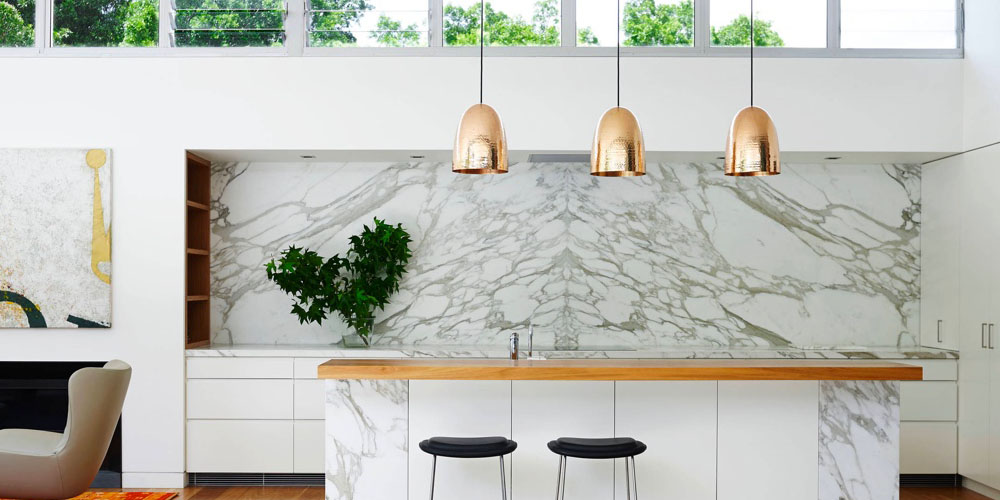
Metal can be found in many places throughout the home, from lighting fixtures to cabinetry hardware. Different metals carry various aesthetic appearances and qualities, and each metal type requires specific maintenance and care. Metal finishes refer to the way a metal is treated and its surface aesthetic. The finish will largely determine the final look and texture of a metal-based item. Most interiors incorporate a diverse variety of metal fixtures, accents, and hardware pieces, with assorted finishes.

Bronze carries a distinctive and highly sought-after look. The material is a metal alloy, made up of of copper, aluminum, tin, and other metals and nonmetals. Bronze is easily recognizable by its brown/gold color with hints of red. Products made from bronze are commonly crafted by hand and highly decorative. Look for bronze faucets or hardware with a PVD coating, to help prevent corrosion and damage. Many “bronze” finish products are actually bronze plate over chrome (and not solid bronze). These alternative hybrid products are less expensive and more readily available than solid bronze.
Pros: Stunning and unique appearance, customizable, long-lasting when cared for properly
Cons: Expensive, slightly pliable, high maintenance
Care: Bronze sinks, faucets, and hardware should be rinsed and wiped down after use. This material can easily be damaged by acidic foods, astringent cleaners, and other liquids and chemicals. Brushed and polished bronze must be treated with a wax cleaner to prevent the metal from darkening to an aged patina color.
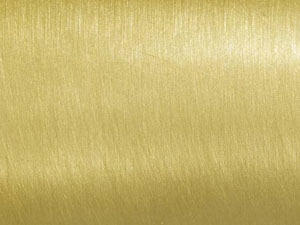
An alloy of copper and zinc with a gold/yellow color, brass has been a favorite in lighting and hardware design for decades. The classic material is seeing a resurgence in popularity, and is available in modern as well as traditional styles. Brass is oftentimes treated with a polished finish for a traditional, upscale look, and is used for lighting rods, fixtures, fireplace doors, and sink faucets. When polished, brass has a very shiny, reflective appearance. Brass’ popularity makes it easy to match with complementary items. Plated brass can be used as a more affordable alternative to solid brass.
Pros: Traditional, upscale appearance, low-maintenance, readily available, durable
Cons: Expensive, may tarnish if left uncleaned for a long period of time
Care: Clean with mild soap and water. Use polish to buff brass and revive its shine
Copper has a red/brown tone that is similar to bronze. The appearance of copper is highly distinct and difficult to replicate with other metals. Copper is naturally occurring and not an alloy. The metal is soft, bendable, and a good conductor of heat and electricity. Copper’s naturally occurring antibacterial properties give it the ability to camouflage scratches and other marks. Any damage to a copper product will darken over time, blending with the rest of the patinaed surface.
Pros: Upscale appearance, good conductor of heat and electricity, naturally lusterous, distinctive color
Cons: May patina to a green/blue color due to natural oxidation process, soft, expensive, not highly durable
Care: Treat with a gentle wax (such as carnauba wax or beeswax) and apply a lacquer to prevent oxidation

Aluminum is a soft and bendable metal with a light silver color. This metal is oftentimes used as a lightweight and less expensive alternative to steel. Aluminum’s highly malleable nature also makes it a popular choice in intricate lighting designs with small spirals or complex curves. Aluminum chandeliers are oftentimes ornamented with glass or crystals, as the two materials pair well, and together achieve a contemporary, sleek aesthetic. Aluminum can easily be recycled, making it an environmentally-conscious choice.
Pros:Lightweight, durable, rust-resistant, low maintenance, inexpensive
Cons:Soft, not as strong as steel, may oxidize
Care:Wash with mild soap and water to remove dust and debris

Wrought iron refers to a construction method where iron-based metal is heated and then hammered or molded into shape. This method of craftsmanship existed long before modern alloy materials and construction techniques were developed (aluminum/steel and cast/poured products). Wrought iron has a rustic, imperfect appearance and texture, and is composed of low-carbon iron mixed with fibrous slag.
Pros: Extremely strong, durable, rustic appearance
Cons: Prone to rusting
Care: Clean wrought iron products with a simple water and mild soap solution. Apply a rust protector to prevent corrosion and use paint to touch up cracks if necessary
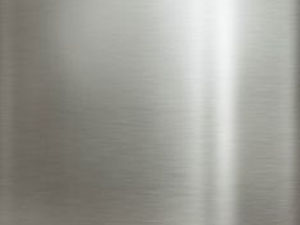
Heavier than aluminum but lighter than iron, steel is a popular middle-of-the-line metal with dark grey coloring. Steel is among the most common metals used in numerous applications and is produced on a massive scale. Among other characteristics, steel is strong, difficult to bend, and difficult to break.
Pros: Extremely strong, durable, inexpensive to produce
Cons: Will oxidize when exposed to water, will rust if left unprotected
Care: Apply a protective finish to steel products to prevent rusting and corrosion. Clean with a mild soap and water solution

Stainless steel is a similar material to steel with one crucial difference. Chromium is added to stainless steel, making the metal corrosion resistant. Stainless steel is very strong, does not hold germs, will not oxidize, and will not corrode. Due to its non-corrosive properties, stainless steel is low maintenance. It is silver in appearance, and more closely resembles aluminum than steel.
Benefits: Strong aluminum alternative, durable, will not rust, corrode, or oxidize
Cons: Expensive to produce
Care: Stainless steel cleans best with a simple vinegar solutionA metal finish refers to the surface appearance of a light fixture, faucet, sink, hardware, or other metal product for the home. Several factors go into determining the finish of a product: the color of the piece, the texture of the piece, and the lustre of the piece. For example, a light fixture could be described as having a polished hammered bronze finish, meaning the fixture is highly lustrous and shiny (polished), has a dented, uneven texture (hammered), and is a brown/gold color (bronze).
Good to Know: A light fixture with a bronze finish may not be crafted from 100% bronze, but may instead be crafted from more inexpensive metals with bronze-colored outer plating. Look for products with solid metal construction for a higher quality product.
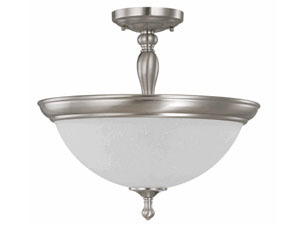
Nickel finishes are similar to chrome, with a shiny lustre and silver color. Nickel is generally much more expensive than chrome, but has a dimensional, warm tone that can be preferred over chrome. Brushed and matte nickel finishes easily conceal watermarks and fingerprints.
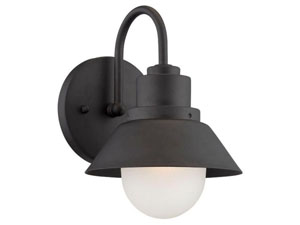
Matte finishes are non-reflective, flat and unshiny, and have a soft appearance. Matte finishes can be any color, from jet black to bronze. A product with a matte finish will not show dirt, fingerprints, watermarks, and is easy to clean.

Oil-rubbed finishes are common to naturally shiny metals such as bronze, brass, and copper. An oil-rubbed finish is intended to mimic the look of an aged, patinaed metal surface. Achieving an oil-rubbed finish is expensive and time-intensive, and in many cases these finishes are created by hand by rubbing premium oils onto the surface of a metal product.
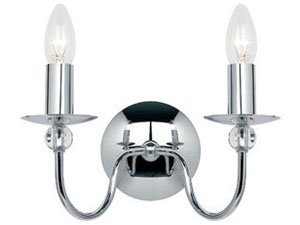
Chrome is one of the most popular contemporary metal finishes for multiple reasons. Chrome is scratch-resistant, versatile, low-maintenance, inexpensive, sleek, and stylish. A chrome finish is achieved by bonding chrome plating over a base material such as brass, copper, or steel. (There is no such thing as a solid chrome faucet or light fixture). The long-term durability of a chrome product depends largely on the quality of the base metal used in crafting the item. Chrome is similar to nickel, with a slightly more vivid silver and shiny appearance.
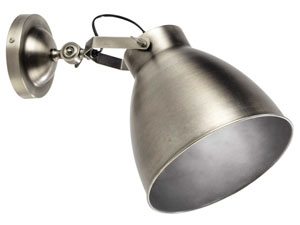
Brushed finishes appear to have been passed over with a paintbrush, leaving faint, thin grooves on the surface of the metal. Brushed finishes are more matte than shiny, and their subtle texture helps to camouflage fingerprints and other marks. Brushed finishes are contemporary, but more warmed up than smooth finishes.
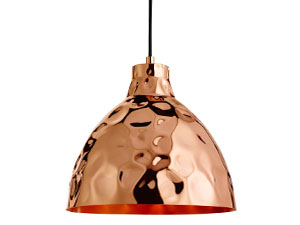
Hammered finishes appear to have been hit many times across their entire surface with a hammer. These finishes feature many small dents and imperfections for a highly textured appearance. The effect is oftentimes achieved by hand.
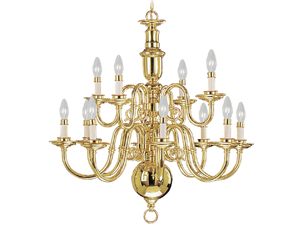
Polished finishes are highly lustrous, reflective, and shiny. To maintain their shine, most polished products need to be routinely buffed. Fingerprints and watermarks show easily on polished finishes, meaning a polished finish is not ideal for faucets or cabinetry hardware. Polished finishes are generally associated with a traditional aesthetic.
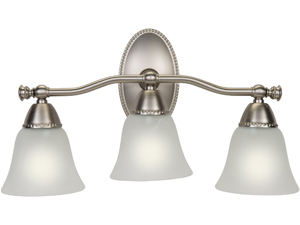
A satin finish is similar to a brushed finish, but with no visible grooves or brushstrokes. The surface of a satin finish is subtly textured, but still very smooth. Satin finishes fall between shiny and matte, and have a rich, warm quality. These finishes can be expensive, but they will not show fingerprints or watermarks.
Understanding the variety of metal types and finishes is key to making informed decisions that enhance your home’s beauty and functionality. Whether you’re seeking durability, elegance, or a specific aesthetic, LuxeDecor's collection of premium metal-based products has something to match your style and needs. From timeless bronze to sleek stainless steel, our curated pieces are crafted for quality and longevity.
Ready to transform your space? Explore LuxeDecor's exclusive range of lighting, furniture, and accents, and bring the perfect blend of sophistication and practicality into your home. Shop with Us Today.



